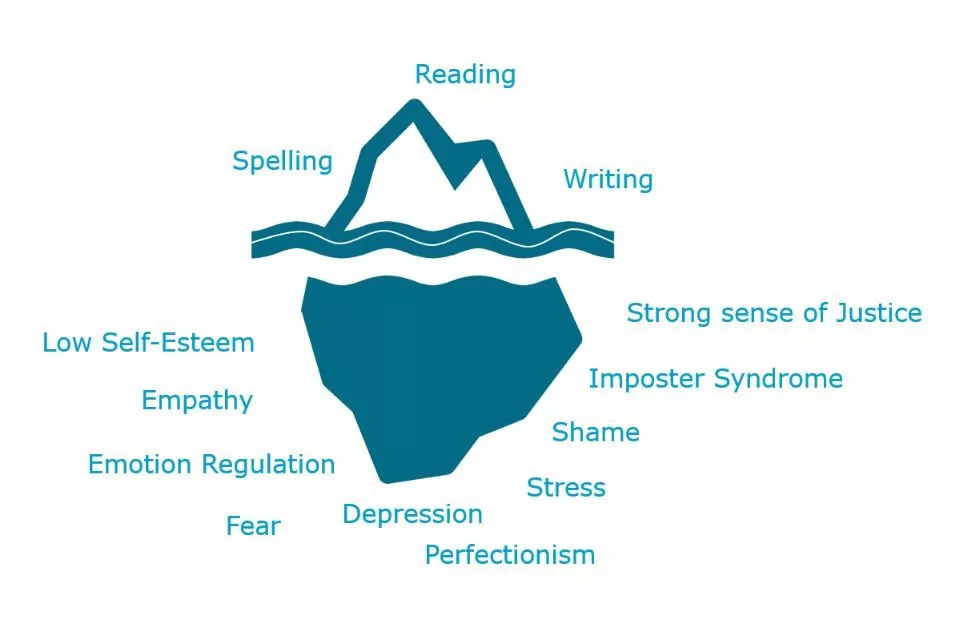
Neurodiversity at work... supporting the people behind the label
2 April 2024
There’s much discuss about neurodiversity at work beyond the reasonable adjustments employers should make and employee rights. Let’s explore the people behind the label, what it means to grow up under the neurodiversity umbrella, and how to ensure your workplace is truly inclusive and supportive.
Antonia Haines, Head of Portfolio Technology at Pluxee UK, talks openly about growing up and working with dyslexia. She’s also kindly shared her experiences to allow us to write this blog on the people behind the label.
Statistics suggest that one in ten people has some level of dyslexia (NHS), and more than 15% of people in the UK are neurodivergent.
Neurodiversity is an umbrella term, a non-medical way of describing people with a ‘variation in their mental functions’ (Forbes), and includes dyslexia, autism, ADHD, and more. Our blog may focus on dyslexia, but Antonia's experiences and emotions apply to many living under the neurodiversity umbrella.
What We See Vs What People Feel
This iceberg image, created by Antonia, is an impactful way to reflect the difference in what we see - what springs to mind when we think about dyslexia - versus what’s happening to the person.
On the surface, most people link dyslexia to spelling, reading, and writing difficulties. It’s a common misconception since there are so many other elements that dyslexia affects, but for argument's sake - the iceberg accurately reflects the way most people view dyslexia.
This is the label, the surface-level difficulties, but what’s happening behind the scenes is much more complex.

Low self-esteem, imposter syndrome, depression, stress, shame, and fear, coupled with high levels of empathy, a strong sense of justice, and perfectionism, are characteristics of dyslexia that you may not see.
Being unseen may mean they go unsupported, which can impact a person more than any difficulties they may have processing words on a page.
The Stress Cycle
One of the lesser-known traits of dyslexia is the inability to verbally articulate your thoughts because locating the correct word can be challenging. Stress negatively impacts everyone’s ability to think clearly, but for a neurodiverse mind, for a person with dyslexia who’s already more predisposed to becoming stressed, this is amplified.
Stress breeds stress.
Consider what this means for someone more prone to low self-esteem and who has difficulty with emotional regulation.
Understanding Neurodiversity at Work
Beyond the role of workplace stress, we, as colleagues and employers, should be aware of how our actions impact people with dyslexia.
How many of us will have - at least once - finished a presentation ten minutes before walking into a meeting?
It happens, and as long as everything is accurate and you know your content, this isn’t an issue. Your colleagues can make notes, digest the information and ask questions.
Except for colleagues with dyslexia.
The dyslexic mind may move quickly, jumping from one thought to the next while others are still catching up, but this isn’t the case when processing data. A dyslexic mind needs more time to read information on a screen, and while others are asking questions, they’re still processing. In the 30 seconds required for a dyslexic mind to be in a position to ask a question, the presenter has often moved on to the next slide.
Antonia has been in this situation during her working life, and, unfortunately, the fear of failure and imposter syndrome have prevented her from speaking out and being heard.
We need to be mindful of our neurodiverse colleagues.
All Antonia needs in this situation is to receive the presentation before the meeting, so when she’s in the room with her peers, she’s already digested the information and prepared her questions.
Masking Neurodiversity at Work
We’ve given a prime example of masking above - not expressing the need for more time to digest information or the chance to prepare.
As Antonia tells us… masking is exhausting.
The dyslexic mind is visual, and even though, as the iceberg shows us, it’s linked to difficulty translating written words, translating phonics without visual cues is also challenging for someone with dyslexia.
We don’t just sit at our desks and do our work when we're in the office. We engage with our colleagues and socialise.
Neurodiverse people can find social situations challenging - for different reasons depending on their type of neurodiversity. For Antonia, the extra time needed to process when someone tells her a joke leads to her having a slower-than-expected response.
It may not seem like a big deal, but when you’re already struggling with imposter syndrome, taking longer to respond to a joke than others, fearing how that may make you look, is another blow to your self-esteem.
The Power of the Neurodiverse Mind
Our aim during this blog is to convey the emotional and personal journey those under the neurodiverse umbrella go on. It doesn’t stop with spelling, reading, and writing. There’s a host of hidden emotions and, in some cases, burdens that your neurodiverse colleagues manage and mask daily.
While some experiences and some elements of life are more challenging than others, there’s much to celebrate.
When chatting with Antonia, she shared that many NASA scientists are neurodiverse. The neurodiverse mind is often visual, and the ability to think in 3D and see the finished product - like how an engine's components will piece together - enhances their success.
Where spelling and grammar may present difficulties, many dyslexic and neurodiverse people thrive in maths, science, and innovation. Here are a few you may have heard of…
- Scientists: Albert Einstein, Thomas Edison, and The Wright Brothers had dyslexia.
- Entrepreneurs: Richard Branson. Steve Jobs and Elon Musk have dyslexia.
- Authors: Lewis Carroll, Hans Christian Anderson, and Agatha Christie had dyslexia.
Every mind can thrive in the right environment and with empathy and support. As employers, colleagues, friends, and family, we must look beneath the tip of the iceberg and take the time to understand the people behind the label to create a truly inclusive environment.
Click here for more information on creating inclusive cultures.
Sources:





